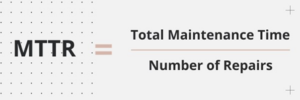When you’re relying on maintenance teams to respond to asset failures, it’s highly important to know those assets’ MTTR. MTTR, or mean time to repair, is a crucial metric used to help maintenance teams improve recovery times when dealing with asset failures. This blog post will discuss mean time to repair, how to calculate it, and how to use it to improve your asset maintenance process.
What is MTTR?
MTTR, or mean time to repair, is a quantifiable metric used to determine the average length of time it takes for an asset to be taken from a state of failure back to its usual performance. Simply put, MTTR refers to how long it usually takes to repair something.
MTTR is calculated using a formula. This will be covered in the sections below.
Why is MTTR important for maintenance?
Mean time to repair can tell you a lot about the health of a facility’s assets and maintenance processes. Conducting an MTTR analysis gives organizations another piece of information that is useful for making informed, data-driven solutions and maximizing their resources.
How is MTTR used?
Once calculated, MTTR can be used in a variety of different maintenance-related scenarios throughout your organization. These include the following:
Deciding whether it’s better to repair or replace your asset.
A variety of factors can result in a higher MTTR, but when asset age leads to your MTTR rocketing upwards, that means it’s better to consider replacing your asset rather than dedicating large amounts of money, time, and effort to maintenance. In a situation where you’re unsure whether to repair or replace your asset, considering that asset’s MTTR is a must.
Planning out a preventive maintenance schedule.
Taking MTTR into account when planning out a preventive maintenance schedule can make a huge difference when it comes to maintenance efficiency. By using MTTR as a maintenance analysis tool, you can much more easily assess where maintenance can be better streamlined for your assets.
For example, if one of your assets’ MTTR is increasing, you can take steps to assess and address any issues the asset might be experiencing. Even though MTTR is measuring asset management from a reactive standpoint, using it as a basepoint for building out a more proactive approach means your maintenance practices can only get better.
Executing MRO inventory purchasing and planning.
MRO inventory is another thing that MTTR can help point you to if you’re finding that asset failure times are longer than expected. For example, if your asset has a lengthy MTTR, it might be worth investigating whether the amount (or more specifically, lack of) spare parts for that asset you have on hand is contributing to that. With information on your asset’s MTTR in hand, you can better make MRO inventory related decisions that will drastically improve your asset maintenance practices.
Organizing your stock items.
MTTR doesn’t account for the amount of time for parts to get delivered to you, but it does account for the amount of time that’s spent searching for parts you already have on hand. Using a high MTTR as a clue, you can look into your organization’s processes to see if spare part organization is a key factor in less-than-efficient repair times.
Fine-tuning your work order process.
A high MTTR can alert you to inefficiencies when it comes to repair practices. For example, are people efficiently trained? Are enough maintenance workers getting alerted to the asset failure to begin with? Using MTTR as a tool can help you uncover any inefficiencies that are occurring in your maintenance process and address them accordingly.
How to calculate MTTR?
Calculating MTTR is done by utilizing a simple formula, which is shown below:
The MTTR of an asset, which is usually represented in hours, is calculated by dividing the total unplanned maintenance time spent on the asset by the total number of failures that asset experienced over a specific period.
MTTR Calculation Formula:

Here’s an example of the mean time to repair the formula in action. Say an asset broke down three times during production last year. The cumulative amount of time it took for the asset to get fully repaired was 38 hours. By plugging these numbers into the MTTR formula, you can get the mean time of repair for this asset:
- Total maintenance time: 38 hours
- Number of repairs: 3
Mean Time To Repair = 38 ÷ 3 = 12.67 hours
Keep in mind that these numbers come from the entire length of time it took between the asset’s initial failure to the completion of its repairs, including these stages:
- Notifying the maintenance team.
- Diagnosing the issue.
- Executing repairs.
- Allowing for equipment to cool down.
- Realigning and recalibrating the asset.
- Testing the asset and ensuring it’s ready to re-enter production.
Also, keep in mind that MTTR is best when examined as a trend. You won’t get much out of a single number, but taking several different MTTRs into consideration – such as a different MTTR for every month in twelve months – can help you identify patterns in your asset’s operational failures.
What is the ideal MTTR?
An ideal MTTR is hard to define because of the sheer degree of variance of several asset-related factors, such as the industry and the age of the asset in question. But as a rule of thumb, the ideal MTTR for an asset is less than five hours.
Who uses MTTR?
The information gathered from calculating MTTR is valuable to many people in many different industries, but it is especially relevant for maintenance managers, maintenance technicians, and production supervisors.
Maintenance managers might use MTTR to try and identify and solve issues in their maintenance processes. Maintenance technicians who inspect assets for issues might use MTTR for the same reason.
How to improve mean time to repair?
Maybe you’ve done your due diligence and calculated MTTR for your asset, and it’s higher than you would like to be. To improve MTTR, you’ll have to use the data you have on hand to look for weak points in your maintenance process.
Focus on being proactive, not reactive.
One of the biggest factors in a longer-than-ideal MTTR is reliance on reactive maintenance. Reactive maintenance is a huge pitfall when it comes to streamlining maintenance practices; it’s essentially waiting for an asset to fail before performing maintenance on it, leading to unexpected downtime and unhappy customers. Therefore, if you want a lower MTTR across the board, you’ll have to practice preventive maintenance to ensure that asset failures are limited and are short in length when they occur.
Look deeply into your team’s maintenance practices and protocols.
There are a myriad of reasons why your MTTR might be high, and you can use many different methods to identify them. A key starting point might be this: Are enough people assigned to the work order to be able to complete it promptly? Do your maintenance teams need more training to increase their efficiency? Are assets being used as intended and not outside of their given functionalities? Take a look into your maintenance team’s routine and asset usage and see if they can be improved in some way.
Make sure your spare parts are organized.
MTTR can become longer if you have no idea where the parts required for repair are located. If you don’t have a reliable way to look up where and how many spare parts you have, it’s highly recommended that you utilize something like a computerized maintenance management system so you can always pull up that information when needed. That way, MTTR isn’t impeded by time spent searching for the correct item.
How to Compare MTTR, MTBF and MTTF?
MTTR is just one factor you can calculate and use to better streamline your asset management practices. There are two other values you can look at and compare with MTTR to assess your maintenance processes: mean time between failures (MTBF) and mean time to failure.
Mean time between failures (MTBF)
The MTBF can be calculated by dividing overall availability by the total number of interruptions. Whereas, MTTR can be calculated by dividing the total time required for maintenance (downtime) by the total number of repairs within a given period. MTTR indicates efficiency in correcting processes, and MTBF indicates the reliability of a system.
MTBF is a measure of the average length of time between an asset’s failures. Naturally, organizations would want a shorter MTBF, because that means that the asset is failing much less than would cause issues in an organization’s daily processes.
MTBF is calculated by dividing the total number of operational hours of an asset (also known as its uptime) by the number of failures it experienced during that timeframe. Take this, for example:
- Total uptime: 12 hours per day for 5 days
- Total breakdowns during this period: 3
MTBF = (12 x 5) / 3 = 20 hours between each failure
Mean time to failure (MTTF)
The MTTF predicts the failure rate of products that cannot be repaired. Whereas, MTTR includes the time needed to determine the fault, diagnose and fix the problem.
In contrast with MTBF, MTTF is a value that describes how long it takes for an asset to fail in the first place. This is an important factor that helps an organization determine how long an asset will typically last.
To calculate MTTF, divide the total hours of operation by the total number of assets in use. See below for an example:
- Total hours of operation for the group of assets: 50,000 hours in the past year
- Total number of assets: 150
MTTF = 50,000 / 150 = a lifespan of about 333 hours for each asset
MTTR, MTBF, and MTTF are all important factors in your maintenance process to consider if you want assets to fail less frequently. As such, you should consider all of them in conjunction if you aim to increase the efficiency and effectiveness of your asset maintenance practices.
Mean Time to Repair vs Mean Time to Recovery
In researching better asset management practices, you might come across the term “Mean Time to Recovery.” Though this term shares an acronym with “Mean Time to Repair,” the two terms are distinguished by a subtle difference.
Mean time to repair refers to the amount of time between the initiation of maintenance and the asset’s return to work. In contrast, mean time to recovery refers to all the time between when downtime begins to when the asset is functional again. As such, mean time to recovery might be much lengthier than mean time to repair.
To calculate the mean time to recovery, add all of the downtime experienced in a specific period and divide it by the number of incidents that occurred. See this example:
- Incidents experienced: Three in 72 hours
- Length of incidents: 30 minutes
Mean time to recovery = 30 / 3 = 10 minutes
How can a CMMS help with MTTR?
Using a computerized maintenance management system (CMMS) helps maintenance teams easily calculate mean time to repair because all work order information is recorded using that software. This includes labor time and individual repair records, which help make up assets’ maintenance history. This maintenance history, which gives insight into how long repairs take, allows maintenance managers to adjust their maintenance practices to accommodate corrective maintenance work.
NEXGEN‘s comprehensive CMMS and EAM solution can be used to track asset maintenance and repair time, including MTTR. To learn more, click the button below to see NEXGEN in action.





